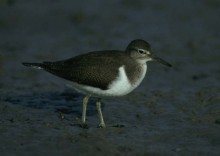Tringa hypoleucos
Subspecies
None.
Other Names
Summer Snipe, Carrier Sandpiper.
Identification
Small wader olive green upperparts and white underparts. Bobs when worried.
Plumage
Non-breeding: The back is olive-brown, with the rest of the upperparts are dark olive-brown each feather has a fine black and white edging. The underparts are white, though there are dark olive-brown patches on the sides of the breast. The rump is white. The tail is olive-brown with white tips on the end of the feathers. There is a pale white supercilium. The bill is of medium length, black with a pale base. The legs are pale yellow.
Breeding: Similar to the non-breeding plumage but the upperparts are darker because the feathers have black tips.
Juvenile: Similar to the non-breeding plumage but the feathers of the upperparts have buff tips.
Distribution
Small number spread through northern areas of Australia, smaller numbers in the southern states. Usually found along coastal rivers and creeks as well as mangroves, but does occur in inland wetlands.
Migratory habits
The Common Sandpiper arrives in Australia in August, some may travel through the interior to the southern states. It leaves our shores in March and April.
Breeding
The Common Sandpiper breeds in a variety of habitats through northern Asia, though not the high-Arctic. Breeds in Korea, Japan as well as mainland Asia.
Status
Widespread throughout Australia in small numbers, so the estimated 3,000 birds may well be an underestimation of the true figure.
Confusing Species
The distinctive plumage and habits make this species easy to identify.

